(272,’2007-02-11 22:28:41′,’david’,’2007-02-11 22:33:50′,’david’,’Mini-Mill Belt Drive Conversion Prototype Version 2′,”,’We finally completed version 2 of the working prototype of the belt drive for the mini-mill. Version 1 worked fine but was clearly just a mock-up. This version closely resembles what will be offered once we clean up a few more details.
This is by far the simplest implementation of the belt drive conversions for the mini mill. While it doesn’t offer step pulleys, we think that the variable speed drive/motor combination works just fine for revving up to 3,000+ RPM with this setup. No belts to change, no pulleys to adjust. All that’s needed is the belt drive unit, belt, timing pulleys and you’re off and running.
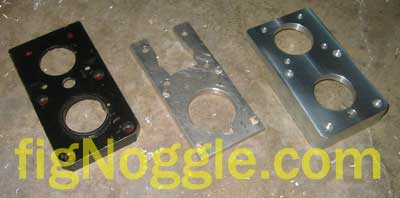
We started with a chunk of billet aluminum and started hogging away at it with the RF-31 mill/drill. There were two time-consuming (far less than with the mini-mill, however) tasks: 1. boring the hole and 2. removing a mass of material. There were also issues found with the round-column mill/drills. When switching between shorter length tooling (end mills, etc. ) and longer length tooling (boring heads, drill chucks, etc.) you have to re-adjust and zero the spindle since the quill only extends 5″ or so and the round column does not keep X-Y positioning. What a pain! Even with the ER-32 collet system, the boring bar still needed to be chucked and therefore required a re-zeroing.
Notice that the bored holes aren’t bored through. This was to save time since the other side needed to be machined away to past that depth.
We made lots of chips ![]()
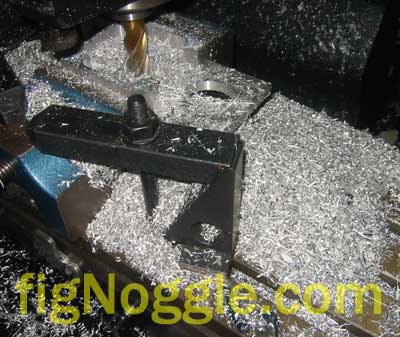
After some time hogging away, we ended up with the prototype. It’s one piece. No spacers, just one single unit. You already saw the top view. Here’s the side (profile) view:
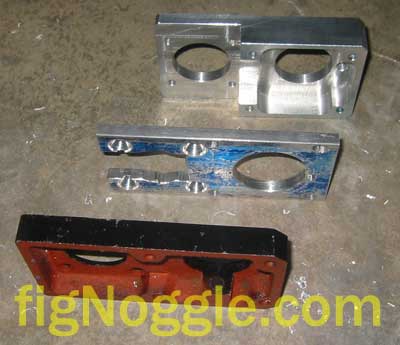
Notice the step.
Now, the underside of the unit:
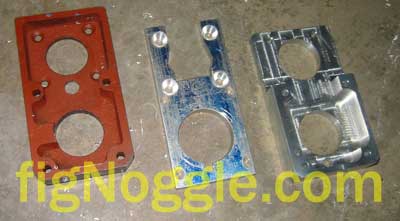
Even with the vibration of the motor spreading to the table of the round column mill/drill, it still makes for quite the hogging machine for rapid machined prototypes (minus the X/Y position-losing problem..)
And, after all that time, here’s the unit mounted to the motor and head:
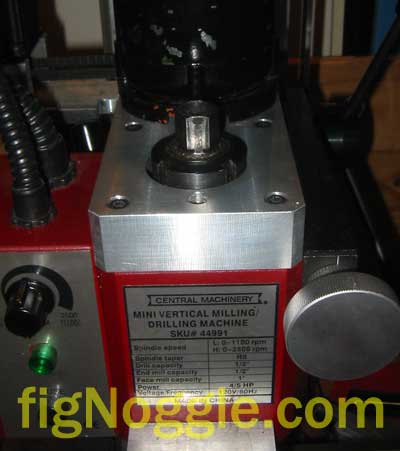
The chamfer is supposed to match the head, but the chamfer bit we had was too small and setting up the part at 45 degrees would take too long for this prototype.
Nice and simple. And it works! Plans? Kits? Coming soon..’,’
We finally completed version 2 of the working prototype of the belt drive for the mini-mill. Version 1 worked fine but was clearly just a mock-up. This version closely resembles what will be offered once we clean up a few more details.
This is by far the simplest implementation of the belt drive conversions for the mini mill. While it doesn’t offer step pulleys, we think that the variable speed drive/motor combination works just fine for revving up to 3,000+ RPM with this setup. No belts to change, no pulleys to adjust. All that’s needed is the belt drive unit, belt, timing pulleys and you’re off and running.

We started with a chunk of billet aluminum and started hogging away at it with the RF-31 mill/drill. There were two time-consuming (far less than with the mini-mill, however) tasks: 1. boring the hole and 2. removing a mass of material. There were also issues found with the round-column mill/drills. When switching between shorter length tooling (end mills, etc. ) and longer length tooling (boring heads, drill chucks, etc.) you have to re-adjust and zero the spindle since the quill only extends 5” or so and the round column does not keep X-Y positioning. What a pain! Even with the ER-32 collet system, the boring bar still needed to be chucked and therefore required a re-zeroing.
Notice that the bored holes aren’t bored through. This was to save time since the other side needed to be machined away to past that depth.
We made lots of chips ![]()

After some time hogging away, we ended up with the prototype. It’s one piece. No spacers, just one single unit. You already saw the top view. Here’s the side (profile) view:

Notice the step.
Now, the underside of the unit:

Even with the vibration of the motor spreading to the table of the round column mill/drill, it still makes for quite the hogging machine for rapid machined prototypes (minus the X/Y position-losing problem..)
And, after all that time, here’s the unit mounted to the motor and head:

The chamfer is supposed to match the head, but the chamfer bit we had was too small and setting up the part at 45 degrees would take too long for this prototype.
Nice and simple. And it works! Plans? Kits? Coming soon..
‘,’We finally completed version 2 of the working prototype of the belt drive for the mini-mill. Version 1 worked fine was clearly just a mock-up. This version closely resembles what will be offered once we clean up a few more details.
This is by far the simplest implementation of the belt drive conversion for the mini mill. While it doesn’t offer step pulleys, we think that the variable speed drive/motor combination works just fine for revving up to 3,000+ RPM with this setup. No belts to change, no pulleys to adjust. All that’s needed is the belt drive unit, belt, timing pulleys and you’re off and running.
 ‘,’
‘,’
We finally completed version 2 of the working prototype of the belt drive for the mini-mill. Version 1 worked fine was clearly just a mock-up. This version closely resembles what will be offered once we clean up a few more details.
This is by far the simplest implementation of the belt drive conversion for the mini mill. While it doesn’t offer step pulleys, we think that the variable speed drive/motor combination works just fine for revving up to 3,000+ RPM with this setup. No belts to change, no pulleys to adjust. All that’s needed is the belt drive unit, belt, timing pulleys and you’re off and running.

‘,”,’Sieg-X2-Mini-Mill’,”,1,’Comment’,0,4,1,1,’article’,”,”,’mini-mill-belt-drive-conversion-prototype-version-2′,”,”,”,”,”,”,”,”,”,”,’cd67232e42cee10b38691adb4dc170c8′,’2007-02-11′);